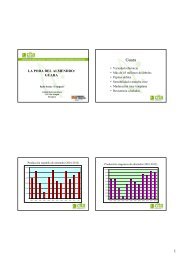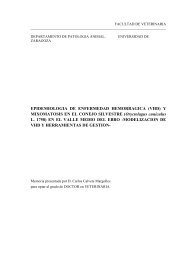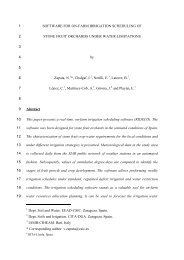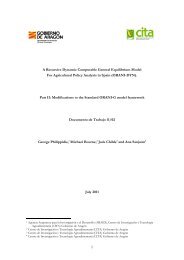Blighia sapida Ackee Blighia sapida Ackee Blighia sapida Ackee
Blighia sapida Ackee Blighia sapida Ackee Blighia sapida Ackee
Blighia sapida Ackee Blighia sapida Ackee Blighia sapida Ackee
You also want an ePaper? Increase the reach of your titles
YUMPU automatically turns print PDFs into web optimized ePapers that Google loves.
<strong>Blighia</strong> <strong>sapida</strong> <strong>Ackee</strong> <strong>Blighia</strong> <strong>sapida</strong> <strong>Ackee</strong> <strong>Blighia</strong> <strong>sapida</strong> <strong>Ackee</strong><br />
Guidelines for<br />
conservation and use<br />
Circa situ conservation, in which trees are<br />
managed in various agroforestry systems (trees<br />
on farmland, home gardens, agroforests, parkland<br />
systems), isa viable approach for ackee conservation.<br />
Guidelines will have to be followed to ensure that<br />
genetic variation is maintained in the production<br />
systems and wild populations must receive in situ<br />
protection in parks and forest reserves to ensure<br />
that the genetic base is maintained.<br />
The best way to guarantee circa situ conservation<br />
of ackee in agroforestry systems is to ensure the<br />
availability of a diversity of types for farmers who<br />
are interested in planting the species. Seeds or<br />
vegetative material for nursery propagation<br />
should be collected from trees meeting various<br />
market-oriented ideotypes, ensuring that nursery<br />
stock will be highly variable in many desirable<br />
traits. Any conservation management programme<br />
should combine local knowledge of the species and<br />
local preferences with scientific genetic knowledge.<br />
Fruits should be collected from 15 to 20 trees<br />
near each village where farmers are interested in<br />
participating in an improvement effort. Farmers<br />
should be involved in selecting treesbased on traits<br />
importantto them. Use and exchange ofgermplasm<br />
should be confined within ecological zones to<br />
avoid negative effects of maladaptation. Involving<br />
both men and women and people of different<br />
ages in selecting trees, collecting fruit and nursery<br />
production will increase the range of traits that<br />
are considered important, thus increasing genetic<br />
variation included in the collection.<br />
If the existing protected areas networks in the<br />
region are properly managed, in situ conservation<br />
of ackee can be accomplished by documenting<br />
the presence of stands and ensuring that<br />
populations remain large and healthy. If ackee is<br />
notpresentin existing protected areasin a particular<br />
region, carefully managed areas providing both in<br />
situ protection and livelihoods for rural people<br />
can be established with the involvement of the<br />
local population and forest authority.<br />
Ex situ conservation should be undertaken if<br />
there is evidence of species decline or of<br />
populations disappearing. Field clone banks will<br />
likely be the most effective means of ex situ<br />
conservation. Sampling for ex situ conservation<br />
should be based on molecular genetic structure<br />
until provenance or progeny trials are established<br />
to evaluate patterns of useful genetic variability. If<br />
the genetic structure in Benin is characteristic of<br />
the structure throughout the species’ range, the<br />
sampling strategy should ensure that all climatic<br />
zones are included, and additional emphasis<br />
should be placed on populations near the most<br />
arid extremes of the range.<br />
Research needs<br />
— Develop in a participative way, an appropriate<br />
low cost vegetative propagation techniques<br />
suitable for farmers in sub-Saharan Africa<br />
— Improve the processing, storage and<br />
packaging of arils<br />
— Determine the number of viable populations<br />
in protected natural areas such as national<br />
parks and the degree to which the<br />
populations are protected within the areas<br />
— Investigate the impact of bark harvest on<br />
viability of populations<br />
— Develop ex situ conservation methods<br />
— Determine genetic variation in drought<br />
tolerance and location of important<br />
sources of variation<br />
— Determine genetic variation in tree growth<br />
and fruit production<br />
— Identify pollinator species, investigate<br />
effective pollen flow and determine threats to<br />
pollinator species<br />
— Investigate effectiveness of seed dispersal and<br />
and degree of dependence on fauna that are<br />
rare or threatened<br />
— Determine effective population sizes in seminatural<br />
farmland populations and minimum<br />
viable populations for conservation and longterm<br />
sustainable use. ■<br />
07
















